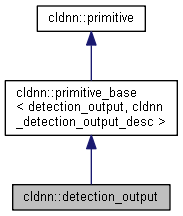Public Types |
Public Member Functions |
Static Public Member Functions |
Public Attributes |
Protected Member Functions |
List of all members
cldnn::detection_output Struct Reference
Generates a list of detections based on location and confidence predictions by doing non maximum suppression. More...
#include <detection_output.hpp>
Inheritance diagram for cldnn::detection_output:

Collaboration diagram for cldnn::detection_output:

Public Types | |
| typedef cldnn_detection_output_desc | dto |
Public Member Functions | |
| detection_output (const primitive_id &id, const primitive_id &input_location, const primitive_id &input_confidence, const primitive_id &input_prior_box, const uint32_t num_classes, const uint32_t keep_top_k, const bool share_location=true, const int background_label_id=0, const float nms_threshold=0.3, const int top_k=-1, const float eta=1.f, const prior_box_code_type code_type=prior_box_code_type::corner, const bool variance_encoded_in_target=false, const float confidence_threshold=-std::numeric_limits< float >::max(), const padding &output_padding=padding()) | |
| Constructs pooling primitive. More... | |
| detection_output (const dto *dto) | |
| Constructs a copy from C API cldnn_detection_output_desc. | |
 Public Member Functions inherited from cldnn::primitive_base< detection_output, cldnn_detection_output_desc > Public Member Functions inherited from cldnn::primitive_base< detection_output, cldnn_detection_output_desc > | |
| const cldnn_primitive_desc * | get_dto () const override |
| Returns pointer to a C API primitive descriptor casted to cldnn_primitive_desc. | |
 Public Member Functions inherited from cldnn::primitive Public Member Functions inherited from cldnn::primitive | |
| primitive (const primitive_type_id &type, const primitive_id &id, const std::vector< primitive_id > &input, const padding &output_padding=padding()) | |
| primitive (const cldnn_primitive_desc *dto) | |
| Constructs a copy from basic C API cldnn_primitive_desc. | |
| std::vector< std::reference_wrapper< primitive_id > > | dependecies () |
| Returns references to all primitive ids on which this primitive depends - inputs, weights, biases, etc. | |
| std::vector< primitive_id > | dependecies () const |
| Returns copy of all primitive ids on which this primitive depends - inputs, weights, biases, etc. | |
| operator primitive_id () const | |
| Implicit conversion to primiitive id. | |
Static Public Member Functions | |
| static primitive_type_id | type_id () |
Public Attributes | |
| const uint32_t | num_classes |
| Number of classes to be predicted. | |
| const int | keep_top_k |
| Number of total bounding boxes to be kept per image after NMS step. | |
| const bool | share_location |
| If true, bounding box are shared among different classes. | |
| const int | background_label_id |
| Background label id (-1 if there is no background class). | |
| const float | nms_threshold |
| Threshold for NMS step. | |
| const int | top_k |
| Maximum number of results to be kept in NMS. | |
| const float | eta |
| Used for adaptive NMS. | |
| const prior_box_code_type | code_type |
| Type of coding method for bounding box. | |
| const bool | variance_encoded_in_target |
| If true, variance is encoded in target; otherwise we need to adjust the predicted offset accordingly. | |
| const float | confidence_threshold |
| Only keep detections with confidences larger than this threshold. | |
 Public Attributes inherited from cldnn::primitive Public Attributes inherited from cldnn::primitive | |
| const primitive_type_id | type |
| Primitive's type id. | |
| const primitive_id | id |
| Primitive's id. | |
| fixed_size_vector_ref | input |
| List of ids of input primitives. | |
| padding | output_padding |
| Requested output padding. | |
Protected Member Functions | |
| void | update_dto (dto &dto) const override |
 Protected Member Functions inherited from cldnn::primitive_base< detection_output, cldnn_detection_output_desc > Protected Member Functions inherited from cldnn::primitive_base< detection_output, cldnn_detection_output_desc > | |
| primitive_base (const primitive_id &id, const std::vector< primitive_id > &input, const padding &output_padding=padding()) | |
| primitive_base (const cldnn_detection_output_desc *dto) | |
 Protected Member Functions inherited from cldnn::primitive Protected Member Functions inherited from cldnn::primitive | |
| virtual std::vector< std::reference_wrapper< const primitive_id > > | get_dependencies () const |
Additional Inherited Members | |
 Protected Attributes inherited from cldnn::primitive Protected Attributes inherited from cldnn::primitive | |
| primitive_id_arr | _input |
Detailed Description
Generates a list of detections based on location and confidence predictions by doing non maximum suppression.
Each row is a 7 dimension vector, which stores: [image_id, label, confidence, xmin, ymin, xmax, ymax]. If number of detections per image is lower than keep_top_k, will write dummy results at the end with image_id=-1.
Definition at line 43 of file detection_output.hpp.
Constructor & Destructor Documentation
◆ detection_output()
|
inline |
Constructs pooling primitive.
- Parameters
-
id This primitive id. input_location Input location primitive id. input_confidence Input confidence primitive id. input_prior_box Input prior-box primitive id. num_classes Number of classes to be predicted. keep_top_k Number of total bounding boxes to be kept per image after NMS step. share_location If true bounding box are shared among different classes. background_label_id Background label id (-1 if there is no background class). nms_threshold Threshold for NMS step. top_k Maximum number of results to be kept in NMS. eta Used for adaptive NMS. code_type Type of coding method for bounding box. variance_encoded_in_target If true, variance is encoded in target; otherwise we need to adjust the predicted offset accordingly. confidence_threshold Only keep detections with confidences larger than this threshold.
Definition at line 62 of file detection_output.hpp.
The documentation for this struct was generated from the following file:
- C:/ML/OpenSource/clDNN/api/CPP/detection_output.hpp
